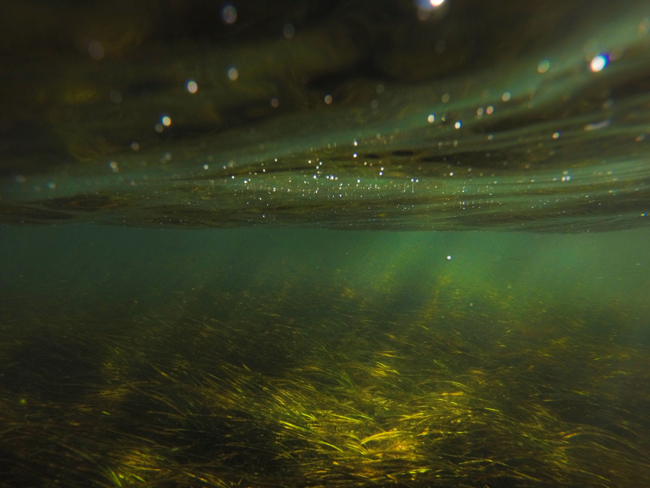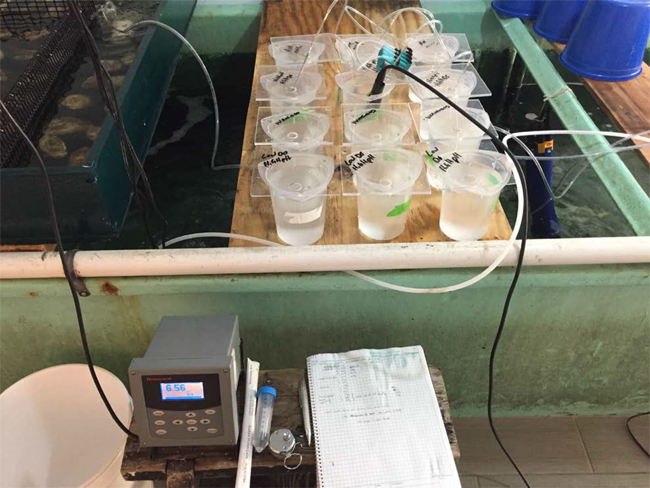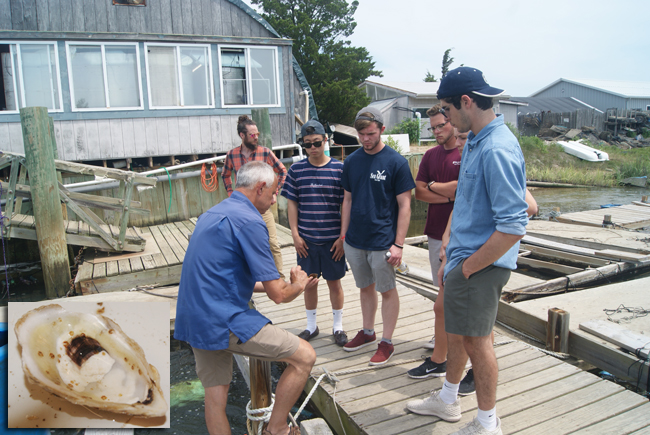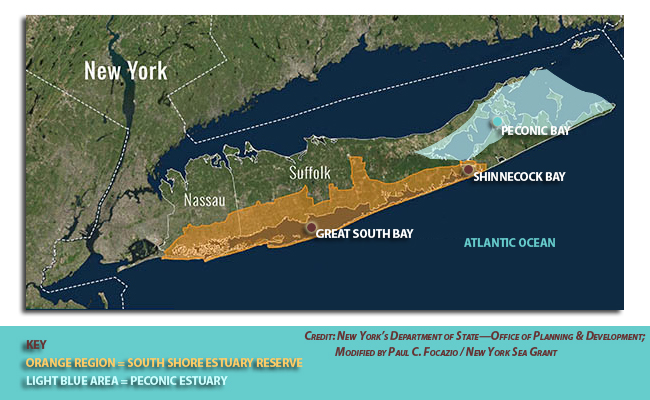
What’s “ocean acidification”? Simply put, absorption of carbon dioxide gas from the atmosphere produces a pH imbalance in our waters, making them more acidic. But seagrasses (pictured above) may provide refugia — areas of more favorable conditions for bivalve species (oysters, clams, mussels and scallops) — from the surrounding acidified waters. Learning how these changes affect seafood is important to fishermen and all those whose enjoyment and culture is connected to the sea. Credit: Kaitlyn O’Toole
— By Chris Gonzales, Freelance Science Writer, New York Sea Grant
Stony Brook, NY, February 3, 2020 — How climate change might impact some aquatic organisms in New York’s waters was the focus of a recently-completed New York Sea Grant-funded study led by researcher Christopher Gobler from Stony Brook University’s School of Marine and Atmospheric Sciences (SBU SoMAS).
The impacts, or stressors – conditions such as acidification, low dissolved oxygen, and large diurnal (day and night) variations in oxygen and acidity – can negatively impact valuable shellfish such as hard clams, oysters, mussels, and bay scallops.

Credit: Andrew Griffith
Ocean acidification and high temperatures affect shellfish growth and survival. Low oxygen also adversely affects them. To illustrate these points, scientists used special equipment to create a chamber of acidified seawater (like in the 2017 test conducted by Gobler’s team in the image above, taken at the Westhampton Beach Shellfish Hatchery). The set-up in this experiment mimics potential future conditions expected due to climate change.
While study results confirmed that such conditions almost certainly will harm the region’s most valuable shellfish growing areas, Gobler and his investigators also examined potential techniques that might alleviate potential damage.
There is hope, as areas of the ocean with abundant seagrass might help to draw down carbon dioxide levels and provide sanctuary for these species in future climate change scenarios.
Shell Strength, Climate Connection
“One-third of the carbon dioxide from fossil fuels has found its way into our oceans,” said Gobler, who presented his findings about climate change and bivalves in a talk at SoMAS in early February 2019.
Gobler warned that carbon in the ocean poses an evident problem for bivalves such as oysters, clams, and mussels. The problem worsens when the “speciation of inorganic carbon”—loosely speaking, the redistribution of carbon between living and non-living things—creates carbonic acid, a weak and unstable acid.
Unfortunately, bivalves dissolve in acidified aquatic environments with too low availability of carbonate. Long ago, in terms of evolutionary time, this was an unlikely problem, since the carbonate levels were significantly higher. As far as bivalves were concerned, the relevant chemical equation needed to produce their sturdy shells was always dependent on carbonate, not calcium. Shifts in the global climate, regrettably, have made carbonate a scarcer commodity in recent decades.
CO2 Levels Outpacing Predictions in Recent Years

NYSG summer 2018 seafood industry interns look at oyster spat on an oyster shell, shown by Gregg Rivara, site director at the Suffolk County Marine Environmental Learning Center in Southold, NY. Spat are the juvenile oysters that will eventually grow to full size. Credit: Michael Ciaramella/NYSG
Shellfish are at risk, worry many scientists, including Gobler.
In New York, many of the top, most-productive fisheries supply “calcifying” shellfish—those prized bivalves such as oysters, mussels, and clams. Their larval stages are quite vulnerable in conditions where ocean acidification has taken place. As these tiny organisms grow from larvae, they must rely entirely on seawater to synthesize calcium carbonate until a shell has developed.
Acidification may already be affecting survival of bivalve larvae—significantly more so than it did during pre-industrial times.
“Big thick shells are stunted [in terms of their growth] by ocean acidification,” reported Gobler. “More often it can lead to smaller, thinner shells,” he continued. “They are in a weaker position in the face of predation and disease. Meanwhile, we know that rivers and coasts have already become more acidic all across the East Coast of the United States.”
In studying the problems that ocean acidification causes, researchers such as Gobler are treating water (in the confined setting of a shellfish hatchery) with sodium carbonate as a means of reducing acidity and improving carbonate availability. This technique, called “buffering,” can help bivalves maintain their protective shells.
Climate’s “Perfect Storm” Scenario
Ocean pH (the way we measure acid or base levels) and ocean acidification are changing faster than at any point in the last 50 million years.
Gobler said we are seeing greater incidences of harmful algal blooms (HABs), low dissolved oxygen, high water temperatures, and increased disease in the region. All of these are significant stressors on bivalve populations. In other words, put them together, you have a perfect storm.
While conducting his research, Gobler wondered, what if you took just two of those factors—acidification and low oxygen—and combined them, how would they affect marine life? His data show that when bivalves are exposed to both conditions simultaneously, it affects them even more adversely.
In short, bivalves are having a difficult time producing shell material.
Seeking safety zones

The Peconic Estuary system (denoted within the light blue area in the map above) is located between the North and South Forks on eastern Long Island. The estuary includes more than 100 distinct bays, harbors, embayments and tributaries, including Flanders Bay, Great Peconic Bay, Little Peconic Bay, Noyac Bay, Shelter Island Sound and Gardiners Bay.
As part of the team’s NYSG-funded project, Gobler has been surveying the Peconic Estuary, scouting for places that might provide suitable habitat for bivalves. He also investigated a particular hypothesis about whether bivalves could “shelter in place” during certain times of the day and night.
Gobler thought that seawater exhibiting diurnal periods of high pH (daily excursions into less-acidic conditions) might allow bivalves to build calcification stores for shells during the day, then relax, so to speak, at night. Thus he devised an experiment to study diurnal pH. Eventually, however, he had to reject this hypothesis. “That refuge did not bear out,” said Gobler.
He wasn’t discouraged, however, in part because there was another strategy he and other scientists wanted to explore: How well would buffering the water with carbonate work?
Gobler and his team observed that adding sodium carbonate to seawater at shellfish hatcheries improved the survival of hard clam larvae. They also observed that putting shell down in aquaculture settings improved sediment chemistry, or the chemical makeup of the seafloor. This led to an increased abundance of “gem” clams (the species Gemma gemma) (1), a species helpful to Northeast marine habitats, but because of their small size they have not been deemed especially commercially significant (2). The findings could be applied, though, to commercial species raised in aquaculture such as hard clams and oysters.
SBU SoMAS researcher Christopher Gobler, among others, discusses the work of Stony Brook's Center for Clean Water Technology, which partners with state and local governments and industry to protect Long Island's endangered water supply. The Stony Brook Center for Clean Water Technology tackles the serious issue of the purity of Long Island groundwater, since it is our only drinking water option, and keeping nitrate, a common groundwater contaminant in suburban areas, from harming our health. More recent videos featuring Gobler and his work included in NYSG's September 2019 news item, "In Media, On YouTube: Protect Your Dog From Harmful Algal Blooms."
Conclusion
“The degree of acidification expected in the 21st century represents a true threat to the future of these fisheries,” said Gobler.
For the time being, scientists are studying how we can best conserve our coastal natural resources, as well as better understand new techniques such as carbonate buffering and promoting seagrass refuges. These techniques just might foster the necessary conditions for shellfish and habitat survival.
For more on this project, see the NYSG story published in August 2017, “In Photos: Changes in the Ocean Affect Economically Important Shellfish.”
Footnotes
(1) From Gobler’s presentation at SoMAS, February 8, 2019.
(2) http://www.iucngisd.org/gisd/species.php?sc=1146 Gemma gemma. Global Invasive Species Database. Accessed May 13, 2019.
References
Bert, T.M. et al. (2011). Natural and anthropogenic forces shape the population genetics and recent evolutionary history of eastern United States bay scallops (Argopecten irradians) Journal of Shellfish Research. 30(3):583-608. DOI: http://dx.doi.org.proxy.library.cornell.edu/10.2983/035.030.0302
Global Invasive Species Database. Gemma gemma. http://www.iucngisd.org/gisd/species.php?sc=1146
Young, C.S., Peterson, B.J. & Gobler, C.J. The Bloom-Forming Macroalgae, Ulva, Outcompetes the Seagrass, Zostera marina, Under High CO2 Conditions. Estuaries and Coasts (2018) 41: 2340. https://doi.org/10.1007/s12237-018-0437-0
Young, C.S., Gobler, C.J. The ability of macroalgae to mitigate the negative effects of ocean acidification on four species of North Atlantic bivalve. Biogeosciences. 15, 6167-6183, 2018 https://doi.org/10.5194/bg-15-6167-2018
More Info: New York Sea Grant
New York Sea Grant (NYSG), a cooperative program of Cornell University
and the State University of New York (SUNY), is one of 34 university-based
programs under the National Oceanic and Atmospheric Administration’s
National Sea Grant College Program.
Since 1971, NYSG has represented a statewide network of integrated
research, education and extension services promoting coastal community
economic vitality, environmental sustainability and citizen awareness
and understanding about the State’s marine and Great Lakes resources.
Through NYSG’s efforts, the combined talents of university scientists
and extension specialists help develop and transfer science-based
information to many coastal user groups—businesses and industries,
federal, state and local government decision-makers and agency managers,
educators, the media and the interested public.
The program maintains Great Lakes offices at Cornell University, SUNY
Buffalo, SUNY Oswego and the Wayne County Cooperative Extension office
in Newark. In the State's marine waters, NYSG has offices at Stony Brook
University in Long Island, Brooklyn College and Cornell Cooperative
Extension in NYC and Kingston in the Hudson Valley.
For updates on Sea Grant activities: www.nyseagrant.org has RSS, Facebook, Twitter, and YouTube links. NYSG offers a free e-list sign up via www.nyseagrant.org/nycoastlines for its flagship publication, NY Coastlines/Currents, which is published quarterly. Our program also produces an occasional e-newsletter,"NOAA Sea Grant's Social Media Review," via its blog, www.nyseagrant.org/blog.